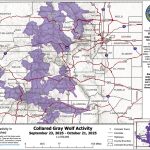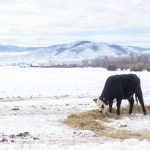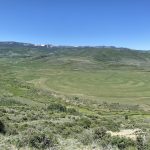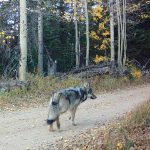Volunteers help with Muddy Slide Fire reforestation efforts

Suzie Romig/Steamboat Pilot & Today
The Muddy Slide Fire that burned almost 4,100 acres in summer 2021 in the Morrison Creek Valley area in South Routt is still living up to its name two years later.
On Thursday morning, teams of volunteers and U.S. Forest Service staff were hard at work planting hundreds of lodgepole pine seedlings when rain turned the dirt roads at the planting site so muddy and slick that the crews had to move to a different location for the afternoon.
“My car was sliding in the mud,” said volunteer coordinator Ryan Messinger, natural climate solutions project manager at nonprofit Yampa Valley Sustainability Council.
Yet, moist soil conditions are just right for planting, according to Silviculturist Aaron Lutz from the Forest Service office in Steamboat Springs.
“It’s been a great spring for this,” Lutz said.
An estimated 80% of the seedlings planted should live to maturity. The lodgepole pine trees will help stabilize and control erosion on steep slopes and bring diversity to the forest after the fire damage, said Silviculturist Ric Ondrejka from the Forest Service office in Yampa.
Ondrejka explained that the intensity of the fire destroyed the pinecones and thus the seed source for lodgepole pines, so the trees could not regenerate on their own.

Lutz expects the seedlings to grow to four to five feet tall in 20 years. The lodgepole will supplement the forest health in the burn area that already is showing signs of natural regrowth of some tiny 2-inch subalpine fir trees as well as shoots of aspen trees that regenerate prolifically on sunny slopes after a fire.
Volunteers did not have to dig too vigorously with their hoedad tree planting tools to clear a small area of competing vegetation and weeds to place the seedlings in shallow holes. The volunteers used pieces of burnt logs or old tree stumps situated above the seedling to help protect the tiny trees from wind and afternoon sun. Then the workers carrying planting bags moved up the hill to plant again at a precise depth on the seedling root crown. Each volunteer planted up to 100 seedlings a day.
Messinger coordinated with Forest Service staff and recruited Yampa Valley Climate Crew volunteers to help reforest about six acres of the Muddy Slide Fire burn scar in three different locations. The assistance of volunteers to get the work done quickly is important because the 3,000 fragile seedlings ordered from a nursery in Nebraska must be stored in a cooler trailer and need to get into the ground efficiently.
The volunteers Friday included sisters Shea and Sloane Speer, both members of the Eco Club at Steamboat Springs High School. Shea, a sophomore, said she enjoyed the volunteer work with like-minded camaraderie while learning about Forest Service projects and having a positive impact on the environment.
Some 30 volunteers worked across three days, June 15-17, to plant seedlings amid the charred conditions and tree snags. The damage from the fire is easily visible in a long swath of grey running along Green Ridge.

The Muddy Slide Fire, located six miles east of the town of Yampa, burned for almost three months mostly within Forest Service land after starting from a lightning strike on June 20, 2021, and was 100% contained on Sept. 14, 2021.
Kevin Thompson, fire management officer at the USFS office in Yampa, said of the lodgepole pine stands within the fire boundary, about 50-60% had already been damaged or killed from pine beetle. That is one reason the fire plume seemed bigger, although the fire was 12 miles south of Stagecoach Reservoir.
When the planting crews walked downhill for a lunch break, Forest Service staff directed people to speak softly and move around a patch of shrubs where a likely two-day-old elk calf was hiding silently. Then the workers, many with soot marks on their faces and clothes, took a break next to a pond at Lynx Pass Ranch, an area where seven trailers, a small cabin and a few outbuildings burned two summers before.

According to the Climate Crew program at Yampa Valley Sustainability Council, damage from more intense fires requires more assistance with reforestation. In addition to the volunteer days, a contracted crew planted another 100 acres of seedlings the previous week.
“Larger and more intense fires resulting from a changing climate are affecting our forests’ ability to regenerate naturally,” according to YVSC. “Reforestation after a wildfire is the first step in creating more resilient forests that will continue to sequester carbon and provide healthy watersheds.”
Messinger said his favorite part about coordinating the volunteer days is working with members of the community who care enough to help with reforestation and other environmental efforts. This is the third year for the Climate Crew program, and volunteers can help with other projects later this summer.
Volunteers will work to restore wet meadows at California Park on Aug. 5-6 by constructing rock structures in streambeds. On Sept. 7-9, volunteers will help with a Forest Service seedling survey at the site of the Big Red Park Fire from 2017 to measure seedling regeneration and map future reforestation for tree planting.
Learn more about Climate Crew opportunities at YVSC.org/yampa-valley-climate-crew.
To reach Suzie Romig, call 970-871-4205 or email sromig@SteamboatPilot.com.

Support Local Journalism

Support Local Journalism
Readers around Steamboat and Routt County make the Steamboat Pilot & Today’s work possible. Your financial contribution supports our efforts to deliver quality, locally relevant journalism.
Now more than ever, your support is critical to help us keep our community informed about the evolving coronavirus pandemic and the impact it is having locally. Every contribution, however large or small, will make a difference.
Each donation will be used exclusively for the development and creation of increased news coverage.










